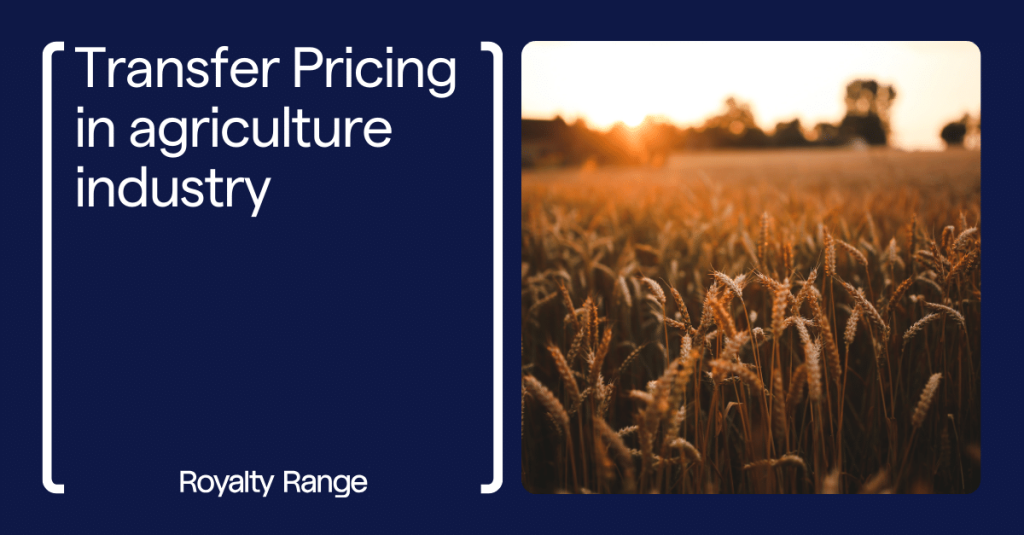Transfer Pricing in agriculture industry
RoyaltyRange

Transfer pricing in agricultural enterprises can present some unique challenges compared to other industries due to the nature of agricultural production and the specific factors that influence pricing and profitability.
The agricultural sector is distinctive, as many unique and depending on nature factors should be taken into consideration:
- Seasonal Variability: Agricultural enterprises often operate within seasonal cycles, with fluctuating production levels and market conditions. This can complicate Transfer Pricing as it may be difficult to establish consistent pricing benchmarks throughout the year.
- Commodity Pricing: Agricultural products are often commodities, subject to price changes based on factors such as weather conditions, global demand, and government policies. This can make it challenging to determine arm’s length prices for intra-group transactions, particularly when market prices are unstable.
- Unique Inputs and Production Processes: Agricultural production relies on unique inputs such as land, water, and specialized equipment, which may not have readily available market prices for comparison. Additionally, production processes in agriculture can vary significantly depending on factors like crop type, climate, and farming practices, further complicating the establishment of transfer prices.
- Regulatory and Subsidy Considerations: Agricultural enterprises may be subject to specific regulations and government subsidies that can impact pricing decisions and Transfer Pricing arrangements. Compliance with agricultural policies and regulations adds another layer of complexity to Transfer Pricing in this sector.
- Geographic Factors: Agricultural enterprises often operate in diverse geographic locations with varying market conditions, infrastructure, and input costs. Transfer Pricing strategies must consider these regional differences to ensure alignment with market realities and regulatory requirements.
- Long Production Cycles: Agricultural production typically involves long production cycles, with significant lead times between planting and harvesting. This extended timeline can affect Transfer Pricing decisions, particularly for transactions involving intermediate inputs or joint production activities.
The UN Tax Committee has revealed an industry-specific set of Transfer Pricing guidance in response to calls from tax administrations in developing countries for more practical guidance on how to apply the arm’s-length principle recently. The papers include agricultural products, particularly coffee and soybean industries.
The role of transaction delineation, comparability analysis, and TP method selection and application issues are emphasized by The UN Tax Committee. It refers to the most relevant business value drivers for multinational enterprises (MNEs) in the agricultural industry in developing countries, including technology development, marketing intangibles, group synergies, cost savings, and hub structures.
The paper says, that “the data show that agricultural products are affected by trade and a high portion of country-specific value added. Assuming that part of that takes place within MNEs either cross-country or within the same country, the Transfer Pricing question of how to properly price transactions between associated enterprises is of high relevance.”
It was mentioned, that the CUP (Comparable Uncontrolled Price) method is the most reliable for commodity transactions when information is available, but notes “the lack of information and/or trustworthy comparables may limit its reliability”. If there’s no possibility to identify internal or external comparables, in most cases companies in the agricultural industry apply TNMM (transaction net margin method).
Transfer Pricing in agricultural enterprises presents unique challenges and considerations compared to other industries. The nature of agricultural production, with its seasonal variability, commodity pricing, and long production cycles, necessitates careful attention to ensure appropriate Transfer Pricing practices.
Sources:
https://documents.un.org/doc/undoc/gen/n23/382/94/pdf/n2338294.pdf?token=sb85OfpVGQmn6BBb1n&fe=true
https://one.oecd.org/document/AGR/CA/APM(2001)24/FINAL/En/pdf
https://www.elibrary.imf.org/display/book/9781475539660/ch003.xml
https://www.researchgate.net/publication/298497178_Transfer_pricing_in_agricultural_enterprises